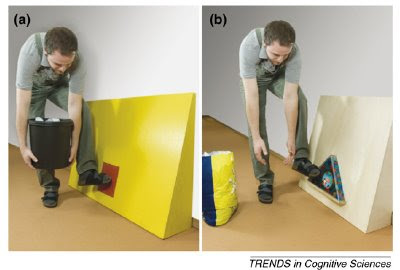Some of you may remember last summer Marc Hauser was found guilty of research misconduct. This investigation raised questions about several publications including a paper from 2007 in Science. This paper looked into the ability of non-human primates to understand the intentions of a human experimenter by interpreting his gestures.
Today Science has published a partial replication of the study in question which confirms the original findings that chimpanzees, cotton-top tamarins, and rhesus macaques can distinguish intentional gestures, such as pointing to indicate a container with food inside, from “accidental” actions such as a hand flopping against a container.
The Science wesite states the following:
Following the Harvard misconduct investigation, first author Justin Wood, now an assistant professor at the University of Southern California in Los Angeles, wrote to Science in June 2010 to notify the journal that the investigation had revealed that the original field notes for the rhesus experiments could not be found:
“An internal examination at Harvard University determined that there are no field notes, records of aborted trials, or subject identifying information associated with the rhesus monkey experiments; however, the research notes and videotapes for the tamarin and chimpanzee experiments were accounted for. Professor Hauser states that “most of the rhesus monkey observations were hand written by [co-author David D.] Glynn on a piece of paper, and then the daily results tallied and reported to Wood over email or by phone” and then the raw data were discarded. The research assistant who performed the experiments (Glynn) confirmed that these field notes were discarded.”
Hauser and Wood returned to Cayo Santiago island in Puerto Rico to redo the experiments from the 2007 paper with the same population of free-ranging rhesus monkeys. Their findings, including field notes and video trials, are available online and they essentially match those reported in the original paper.
It is still not known what went wrong with the original experiment, a statement issued by Science today only says the following:
We stress that this new publication aims only to determine whether the original rhesus monkey experiments from the 2007 paper can be replicated. It has no bearing on questions raised about Dr. Hauser’s larger body of work.
This article from Science Inside quotes Dario Maestriperi as saying:
“The results of this replication are straightforward and entirely consistent with those of the original study. If the authors’ interpretation of their results is correct, these findings are very important and represent one of the clearest demonstrations that nonhuman primates can interpret the behavior of other individuals as intentional or non-intentional….Since the experimenter who tested the rhesus monkeys in the replication study appeared from the video to be the first author on the paper, Justin Wood, he was clearly knowledgeable of the hypotheses being tested and had some strong expectations and desires about the monkeys’ performance on the test.”
So is this replication a clarification of groundbreaking findings or could the monkey’s behaviour be down to the Clever Hans effect?
Meanwhile investigations into Hauser’s research are still ongoing and he is still banned from teaching for the next academic year.





